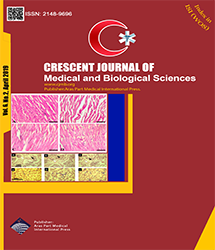
| Original Article | |
| Effect of Dry Needling on miR-939 and miR-25 Serum Levels in Myofascial Pain Syndrome With Shoulder Girdle Myofascial Trigger Points | |
| Mehrdad Naghikhani1, Hamid Tayefi Nasrabadi1, Jafar Soleimanirad2, Mohammad Taghi Joghataei3, Amir Massoud Arablu4 | |
| 1Department of Anatomical Science, Faculty of Medicine, Tabriz University of Medical Sciences, Tabriz, Iran 2Immunology Research Center, Tabriz University of Medical Sciences, Tabriz, Iran 3Cellular and Molecular Research Center, Department of Anatomical Science, Iran University of Medical Sciences, Tehran, Ira 4Department of Physical Therapy, University of Social Welfare and Rehabilitation Sciences, Tehran, Iran |
|
|
CJMB 2019; 6: 231-236 Viewed : 4784 times Downloaded : 3134 times. Keywords : MicroRNA, miR-939, miR-25, Pain, MTrPs, Muscle pain, Dry needling |
|
| Full Text(PDF) | Related Articles | |
| Abstract | |
Objectives: Micro-RNAs (miRs) affect the gene expression of the pain and inflammation mediators. Myofascial trigger points (MTrPs) are one of the most common causes of skeletal and muscle pain. In this regard, dry needling (DN) was favored by physiotherapists as an effective method of treatment for mucopolysaccharidosis. The present study aimed to assess the effectiveness of DN on serum concentration of miR-939 and miR-25 before and after the treatment in patients with muscular pain caused by MTrPs in their shoulder girdle muscles. Methods: Twenty patients with pain in their shoulders, upper limbs, along with heads and necks, who had 3-5 active MTrPs in their shoulder girdle muscles participated in the study. They were treated in 5 sessions with DN. One session was held per day every three days for 2 weeks. Before and after the treatment, the pain intensity of the patients was measured using the visual analogue scale (VAS), their peripheral blood samples were taken, and miR serum concentrations were estimated by real-time polymerase chain reaction. Results: Comparing pain intensity in patients revealed a significant reduction after the treatment (P<0.05). In addition, statistical analysis indicated up-regulation of miR-939 and miR-25 with a significant difference (P<0.05) after the treatment compared to the time before the treatment. Conclusion: According to the reduction in pain intensity and increased expression of miR-939 and miR-25 serum levels after treatment, it can be concluded that DN is an effective technique for treatment of mucopolysaccharidosis in shoulder girdle muscles. |
Cite By, Google Scholar
Google Scholar
PubMed
Online Submission System
 CJMB ENDNOTE ® Style
CJMB ENDNOTE ® Style
 Tutorials
Tutorials
 Publication Charge
Medical and Biological Research Center
About Journal
Publication Charge
Medical and Biological Research Center
About Journal
Aras Part Medical International Press Editor-in-Chief
Arash Khaki
Deputy Editor
Zafer Akan


















